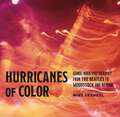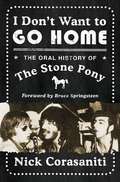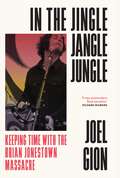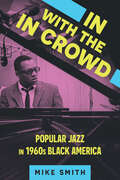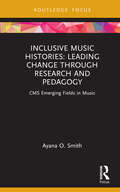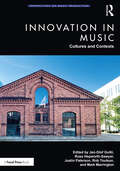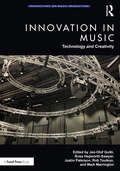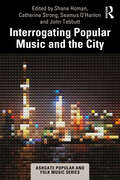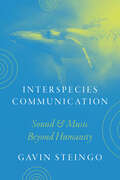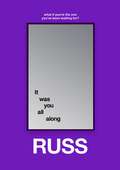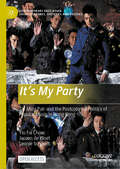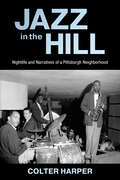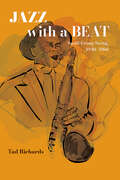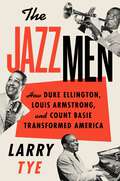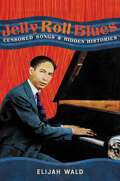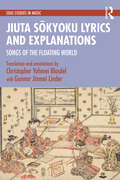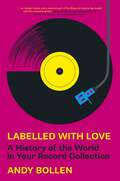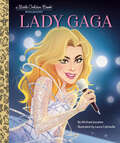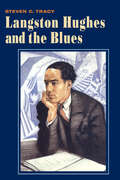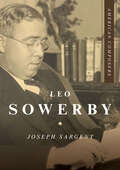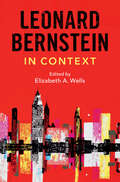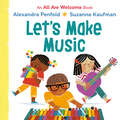- Table View
- List View
Hurricanes of Color: Iconic Rock Photography from the Beatles to Woodstock and Beyond (American Music History)
by Mike FrankelIn 1964, fifteen-year-old Mike Frankel found himself among professional photojournalists covering a Beatles concert during the band’s first tour in the United States. A few years later, he was a regular photographer at the Fillmore East, a storied venue in classic rock. And in 1969, he was onstage at Woodstock, documenting one of the most important events in American music history.Featuring Frankel’s stunning photographs of nearly every major rock figure from the 1960s and ’70s—including Led Zeppelin, Pink Floyd, the Rolling Stones, Janis Joplin, and the Grateful Dead—as well as many unpublished images of the Beatles, Hurricanes of Color chronicles an extraordinary moment. Frankel, who was for a time a personal photographer for Jefferson Airplane and Hot Tuna, developed an innovative style—one that layered images with multiple exposures to capture the spirit of the music of the era and the experience of listening to the bands live.A must-have for fans of classic rock, this is a spectacular and profound collection of photography that complements the music of the world’s biggest performers.
I Don't Want to Go Home: The Oral History of the Stone Pony
by Nick CorasanitiA captivating oral history of the iconic music venue the Stone Pony and of the rise, fall, and rebirth of Asbury Park, New Jersey—featuring interviews with Bruce Springsteen, Steve Van Zandt, Southside Johnny, members of the E Street Band and Asbury Jukes, the Ramones, the Jonas Brothers, Jack Antonoff, and other legendary musicians.Featuring exclusive, never-before-seen photos from Danny ClinchIn 1970, Asbury Park, New Jersey, was ripped apart by race riots that left the once-proud beach town an hour away from Manhattan smoldering, suffering and left for dead.Four years later, a few miles down the coast in Seaside Heights, two bouncers, Jack Roig and Butch Pielka, tired of the daily grind, dreamt of owning their own place. Under-prepared and minimally funded, the two bought the first bar they considered, in a city where no one wanted to be, without setting one foot in the place. They named it the Stone Pony, and turned it into a rock club that Bruce Springsteen would soon call home and a dying town would call its beating heart.But the bar had to fight to survive. Despite its success in launching and attracting rockers like Stevie Van Zandt, “Southside” Johnny Lyon, and Springsteen, the Stone Pony—like everything in Asbury Park for the past half century—could only weather the drags of a depressed city for so long.How did the Stone Pony beat the odds to survive? How did it become an international rock pilgrimage site, not just for fans of Springsteen, but for punk rockers, jam bands, pop, indie, alternative and many other musicians as well? And how did it continue to inspire and influence a hall-of-fame list of New Jersey and national rock stars? The story of the Stone Pony—thrillingly charted in this detailed oral history—is the chronicle of a proud and unique cultural mecca blooming in a down-but-not-yet-out tough town. As Nick Corasaniti reveals, the stories of Asbury Park and the Stone Pony are that of modern America itself—a place of battered hopes, big dreams, and dogged resilience.
In the Jingle Jangle Jungle: Keeping Time with the Brian Jonestown Massacre
by Joel GionThe Brian Jonestown Massacre are one of the great contemporary cult American rock and roll bands. At the peak of their anarchic reign in the San Francisco underground of the mid '90s their psychedelic output was almost as prodigious and impressive as their narcotic intake. Immortalised in one of the most unforgettable rock and roll documentaries of all time, DIG! alongside their friends/rivals/nemeses, The Dandy Warhol's, in their early years when the US were obsessed with grunge, the BJM felt like a '60s anachronism. But with albums like Their Satanic Majesties Second Request and Thank God for Mental Illness, and incendiary, often chaotic, live shows, they burnished their legend as true believers and custodians of the original west coast flame; a privilege and responsibility which continues to this day when the band have a bigger and more dedicated audience than ever.Joel Gion's memoir tells the story of the first ten years of the band from the Duke Seat. A righteous account of the hazards and pleasures of life on and off the road, In the Jingle Jangle Jungle takes use behind the scenes of the supposed behind the scenes film that cemented the band's legend. Funny as hell, shot through with the innocence and wonder of a 'percussionist' whose true role is that of the band's 'spirit animal', In the Jingle Jangle Jungle is destined to take its place alongside cult classics in the pantheon of rock and roll literature like Playing the Bass with Three Left Hands, Head On, and 45 by Bill Drummond. It will also feature a foreword by Anton Newcombe, fellow member and founder of The Brian Jonestown Massacre.
In with the In Crowd: Popular Jazz in 1960s Black America (American Made Music Series)
by Mike SmithMost studies of 1960s jazz underscore the sounds of famous avant-garde musicians like John Coltrane, Ornette Coleman, and Albert Ayler. Conspicuously absent from these narratives are the more popular jazz artists of the decade that electrified dance clubs, permeated radio waves, and released top-selling records. Names like Eddie Harris, Nancy Wilson, Ramsey Lewis, and Jimmy Smith are largely neglected in most serious work today. Mike Smith rectifies this oversight and explores why critical writings have generally cast off best-selling 1960s jazz as unworthy of in-depth analysis and reverent documentation.The 1960s were a time of monumental political and social shifts. Avant-garde jazz, made by musicians indifferent to public perception aligns well with widely held images of the era. In with the In Crowd: Popular Jazz in 1960s Black America argues that this dominant, and unfortunately distorted, view negates and ignores a vibrant jazz community. These musicians and their listeners created a music defined by socialization, celebration, and Black pride.Smith tells the joyful story of the musicians, the radio DJs, the record labels, and the live venues where jazz not only survived but thrived in the 1960s. This was the music of everyday people, who viewed jazz as an important part of their cultural identity as Black Americans. In an era marked by turmoil and struggle, popular jazz offered a powerful outlet for joy, resilience, pride, and triumph.
Inclusive Music Histories: CMS Emerging Fields in Music (CMS Emerging Fields in Music)
by Ayana O. SmithInclusive Music Histories: Leading Change through Research and Pedagogy models effective practices for researchers and instructors striving either to reform music history curricula at large or update individual topics within their classes to be more inclusive. Confronting racial and other imbalances of Western music history, the author develops four core principles that enable a shift in thinking to create a truly intersectional music history narrative and provides case studies that can be directly applied in the classroom. The book addresses inclusivity issues in the discipline of musicology by outlining imbalances encoded into the canonic repertory, pedagogy, and historiography of the field. This book offers comprehensive teaching tools that instructors can use at all stages of course design, from syllabus writing and lecture planning to discussion techniques, with assignments for each of the subject matter case studies. Inclusive Music Histories enables instructors to go beyond token representation to a more nuanced music history pedagogy.
Inclusive Music Histories: CMS Emerging Fields in Music (CMS Emerging Fields in Music)
by Ayana O. SmithInclusive Music Histories: Leading Change through Research and Pedagogy models effective practices for researchers and instructors striving either to reform music history curricula at large or update individual topics within their classes to be more inclusive. Confronting racial and other imbalances of Western music history, the author develops four core principles that enable a shift in thinking to create a truly intersectional music history narrative and provides case studies that can be directly applied in the classroom. The book addresses inclusivity issues in the discipline of musicology by outlining imbalances encoded into the canonic repertory, pedagogy, and historiography of the field. This book offers comprehensive teaching tools that instructors can use at all stages of course design, from syllabus writing and lecture planning to discussion techniques, with assignments for each of the subject matter case studies. Inclusive Music Histories enables instructors to go beyond token representation to a more nuanced music history pedagogy.
Innovation in Music: Cultures and Contexts (ISSN)
by Jan-Olof Gullö Russ Hepworth-Sawyer Justin Paterson Rob Toulson Mark MarringtonInnovation in Music: Cultures and Contexts is a groundbreaking collection bringing together contributions from instructors, researchers, and professionals. Split into two sections, covering creative production practices and national/international perspectives, this volume offers truly global outlooks on ever-evolving practices.Including chapters on Dolby Atmos, the history of distortion, creativity in the pandemic, and remote music collaboration, this is recommended reading for professionals, students, and researchers looking for global insights into the fields of music production, music business, and music technology.
Innovation in Music: Technology and Creativity (ISSN)
by Jan-Olof Gullö Russ Hepworth-Sawyer Justin Paterson Rob Toulson Mark MarringtonInnovation in Music: Technology and Creativity is a groundbreaking collection bringing together contributions from instructors, researchers, and professionals. Split into two sections, covering composition and performance, and technology and innovation, this volume offers truly international perspectives on ever-evolving practices.Including chapters on audience interaction, dynamic music methods, AI, and live electronic performances, this is recommended reading for professionals, students, and researchers looking for global insights into the fields of music production, music business, and music technology.
Interrogating Popular Music and the City (ISSN)
by Catherine Strong Shane Homan Seamus O'Hanlon John TebbuttHow does popular music influence the culture and reputation of a city, and what does a city do to popular music? Interrogating Popular Music and the City examines the ways in which urban environments and music cultures intersect in various locales around the globe. Music and cities have been partners in an often clumsy, sometimes accidental but always exciting dance. Heritage and immigration, noise and art, policy and politics are some of the topics that are addressed in this critical examination of relationships between cities and music. The book draws upon an international array of researchers, encompassing hip hop in Beijing; the city favelas of Brazil; from Melbourne bars to European parliaments; to heritage and tourism debates in Salzburg and Manchester. In doing so, it interrogates the different agendas of audiences, musicians and policy-makers in distinct urban settings.
Interspecies Communication: Sound and Music beyond Humanity
by Gavin SteingoA surprising study reveals a plethora of attempts to communicate with non-humans in the modern era. In Interspecies Communication, music scholar Gavin Steingo examines significant cases of attempted communication beyond the human—cases in which the dualistic relationship of human to non-human is dramatically challenged. From singing whales to Sun Ra to searching for alien life, Steingo charts the many ways we have attempted to think about, and indeed to reach, beings that are very unlike ourselves. Steingo focuses on the second half of the twentieth century, when scientists developed new ways of listening to oceans and cosmic space—two realms previously inaccessible to the senses and to empirical investigation. As quintessential frontiers of the postwar period, the outer space of the cosmos and the inner space of oceans were conceptualized as parallel realities, laid bare by newly technologized “ears.” Deeply engaging, Interspecies Communication explores our attempts to cross the border between the human and non-human, to connect with non-humans in the depths of the oceans, the far reaches of the universe, or right under our own noses.
It Was You All Along
by RussThe self-made musical artist follows his bestseller IT’S ALL IN YOUR HEAD with this second inspirational book for everyone who’s looking for answers in all the wrong places. It’s a book about self-empowerment, self-awareness, and ultimately self-love.Independent rapper, songwriter, singer, and producer Russ sells out concerts across America and around the globe, collaborating with top artists, such as Snoop Dogg, Joey Bada$$, Ed Sheeran, Rick Ross, Lil Baby, Jadakiss, Bia, and Mozzy to name a few. At twenty-seven, he became a bestselling author with the publication of his debut book, IT’S ALL IN YOUR HEAD. Now, at thirty-one, Russ returns with a second book even more profound and intimate than his first. Building on his message of self-acceptance, It Was You All Along goes deeper into Russ’s heart and soul as it tracks the keys to knowing and loving yourself.The book addresses the question posed by the subtitle—what if you’re the one you’ve been waiting for?—a line from Russ’s first album inspired by his mother’s advice. Success comes from loving and believing in yourself and working hard regardless of obstacles and naysayers. Published in conjunction with his tour of the same name, It Was You All Along expands on themes found in Russ’s music and across his albums, and each chapter title takes the name of a track. Russ has always followed his own beat—and shows you how to find your own unique rhythm, offering motivational wisdom on everything from trust, discipline, and letting go to authenticity, joy, and faith.Packed with moving observances, It Was You All Along gives fans a rare look into the man behind the music and the challenges he continues to face both personally and as an independent artist. Russ gets deeply personal in these pages, revealing how seeing a therapist helped him understand his relationship with his family and realize that he was so overly focused on helping everyone in his orbit when the person who needed his attention most was himself.Russ uses his immense passion, his experiences, and his love for people to inspire us all. His honesty and straightforwardness will convince even the most reluctant reader that the answer can always be found within. An artist known for his powerful lyrics, Russ uses his songwriting gifts to craft prose that is moving, memorable, and motivational.
It’s My Party: Tat Ming Pair and the Postcolonial Politics of Popular Music in Hong Kong (Contemporary East Asian Visual Cultures, Societies and Politics)
by Jeroen de Kloet Yiu Fai Chow Leonie SchmidtThis book is unique in focusing on just one band from one city – but the story of Tat Ming Pair, in so many ways, is the story of Hong Kong's recent decades, from the Handover to the Umbrella Movement to 2019's standoff. A comprehensive, theoretically informed study of the sonic history and present of Hong Kong through the prism of Tat Ming Pair, this book will be of interest to cultural studies scholars, scholars of Hong Kong, and those who study the arts in East Asia.This is an open access book.
Jazz in the Hill: Nightlife and Narratives of a Pittsburgh Neighborhood (American Made Music Series)
by Colter HarperFrom the 1920s through the 1960s, Pittsburgh’s Hill District was the heart of the city’s Black cultural life and home to a vibrant jazz scene. In Jazz in the Hill: Nightlife and Narratives of a Pittsburgh Neighborhood, Colter Harper looks at how jazz shaped the neighborhood and created a way of life. Beyond backdrops for remarkable careers, jazz clubs sparked the development of a self-determined African American community. In delving into the history of entrepreneurialism, placemaking, labor organizing, and critical listening in the Hill District, Harper forges connections to larger political contexts, processes of urban development, and civil rights struggles.Harper adopts a broad approach in thinking about jazz clubs, foregrounding the network of patrons, business owners, and musicians who were actively invested in community building. Jazz in the Hill provides a valuable case study detailing the intersections of music, political and cultural history, public policy, labor, and law. The book addresses distinctive eras and issues of twentieth century American urban history, including notions of “vice” during the Prohibition Era (1920–1934); “blight” during the mid-twentieth century boom in urban redevelopment (1946–1973); and workplace integration during the civil rights era (1954–1968). Throughout, Harper demonstrates how the clubs, as a nexus of music, politics, economy, labor, and social relations, supported the livelihood of residents and artists while developing cultures of listening and learning. Though the neighborhood has undergone an extensive socioeconomic transformation that has muted its nightlife, this musical legacy continues to guide current development visions for the Hill on the cusp of its remaking.
Jazz with a Beat: Small Group Swing, 1940–1960 (Excelsior Editions)
by Tad RichardsJazz with a Beat is the first book on the often overlooked but vitally important genre of small group swing jazz. Coming into being in the early 1940s, small group swing answered the need in the Black community for a form of jazz that was more accessible (and more danceable) than the new bebop. An adaptation of the big band Black swing (Erskine Hawkins, Jimmie Lunceford, Chick Webb) of the 1930s to small combos, and with a more vigorous beat for the new generation, this music developed and was beloved through the 1940s, continued to be enjoyed through the rock and roll years of the 1950s, and was a major influence on the soul jazz of the 1960s. Among the many hit artists portrayed in these pages are Illinois Jacquet, Louis Jordan, Big Jay McNeely, Joe Liggins, Nat "King" Cole, Red Prysock, Ruth Brown, Nellie Lutcher, Camille Howard, T-Bone Walker, and Ray Charles. Dismissed as "rhythm and blues," this music has been ignored by jazz historians. Jazz with a Beat honors this music as a legitimate genre of jazz and is a stirring evocation of an era. It should be of interest to lovers of jazz and Americana.
The Jazzmen: How Duke Ellington, Louis Armstrong, and Count Basie Transformed America
by Larry TyeFrom the New York Times bestselling author of Satchel and Bobby Kennedy, a sweeping and spellbinding portrait of the longtime kings of jazz—Duke Ellington, Louis Armstrong, and Count Basie—who, born within a few years of one another, overcame racist exclusion and violence to become the most popular entertainers on the planet.This is the story of three revolutionary American musicians, the maestro jazzmen who orchestrated the chords that throb at the soul of twentieth-century America.Duke Ellington, the grandson of slaves who was christened Edward Kennedy Ellington, was a man whose story is as layered and nuanced as his name suggests and whose music transcended category.Louis Daniel Armstrong was born in a New Orleans slum so tough it was called The Battlefield and, at age seven, got his first musical instrument, a ten-cent tin horn that drew buyers to his rag-peddling wagon and set him on the road to elevating jazz into a pulsating force for spontaneity and freedom.William James Basie, too, grew up in a world unfamiliar to white fans—the son of a coachman and laundress who dreamed of escaping every time the traveling carnival swept into town, and who finally engineered his getaway with help from Fats Waller.What is far less known about these groundbreakers is that they were bound not just by their music or even the discrimination that they, like nearly all Black performers of their day, routinely encountered. Each defied and ultimately overcame racial boundaries by opening America’s eyes and souls to the magnificence of their music. In the process they wrote the soundtrack for the civil rights movement.Based on more than 250 interviews, this exhaustively researched book brings alive the history of Black America in the early-to-mid 1900s through the singular lens of the country’s most gifted, engaging, and enduring African-American musicians.
Jelly Roll Blues: Censored Songs and Hidden Histories
by Elijah WaldA bestselling music historian follows Jelly Roll Morton on a journey through the hidden worlds and forbidden songs of early blues and jazz. In Jelly Roll Blues: Censored Songs and Hidden Histories, Elijah Wald takes readers on a journey into the hidden and censored world of early blues and jazz, guided by the legendary New Orleans pianist Jelly Roll Morton. Morton became nationally famous as a composer and bandleader in the 1920s, but got his start twenty years earlier, entertaining customers in the city&’s famous bordellos and singing rough blues in Gulf Coast honky-tonks. He recorded an oral history of that time in 1938, but the most distinctive songs were hidden away for over fifty years, because the language and themes were as wild and raunchy as anything in gangsta rap. Those songs inspired Wald to explore how much other history had been locked away and censored, and this book is the result of that quest. Full of previously unpublished lyrics and stories, it paints a new and surprising picture of the dawn of American popular music, when jazz and blues were still the private, after-hours music of the Black "sporting world." It gives new insight into familiar figures like Buddy Bolden and Louis Armstrong, and introduces forgotten characters like Ready Money, the New Orleans sex worker and pickpocket who ended up owning one of the largest Black hotels on the West Coast. Revelatory and fascinating, these songs and stories provide an alternate view of Black culture at the turn of the twentieth century, when a new generation was shaping lives their parents could not have imagined and art that transformed popular culture around the world—the birth of a joyous, angry, desperate, loving, and ferociously funny tradition that resurfaced in hip-hop and continues to inspire young artists in a new millennium.
Jiuta Sōkyoku Lyrics and Explanations: Songs of the Floating World (ISSN)
by Christopher Yohmei Blasdel Gunnar Jinmei LinderJiuta Sōkyoku Lyrics and Explanations is a compendium of seventy-three representative songs from the well-known genre of traditional Japanese Edo-period sankyoku ensemble music.Including extensive annotations along with commentaries and notes on their musical and performative aspects, the collection begins with an overview which traces the history of the jiuta sōkyoku genre and the various socio-political influences at work in its formation. The translations and analyses are followed by a substantive glossary and bibliography, allowing for a deeper understanding of both the literary and musical aspects of jiuta sōkyoku compositions.Jiuta Sōkyoku Lyrics and Explanations is a comprehensive anthology that will be of great interest to researchers, including ethnomusicologists, Japanese studies scholars and poetry lovers who are fascinated with the literary and musical impact of the Edo period.
John Zorn’s File Card Works: Hypertextual Intermediality in Composition and Analysis (ISSN)
by Maurice WindleburnThis book is the first study of John Zorn’s ‘file card’ works, with special focus made on the pieces Godard (1985), Spillane (1986), Interzone (2010), and Liber Novus (2010). It explains the unique creative process behind these compositions, contextualizing them in relation to the history of file cards, the ‘open work’ concept, cinematic listening, and uncreative aesthetics. Semiotic, hermeneutic, and ekphrastic analyses draw hypertextual links between the four file card compositions and the worlds of their respective dedicatees: author Mickey Spillane, filmmaker Jean-Luc Godard, novelist William S. Burroughs and painter Brion Gysin, and psychiatrist C. G. Jung.This book will appeal not only to those interested in Zorn’s music, but also to scholars of music semiotics and hermeneutics, intermedia studies, and avant-garde music.
Labelled with Love: A History of the World in Your Record Collection
by Andy Bollen‘… an instant classic and a required part of the library of anyone fascinated with the record business.’ – Danny Goldberg, bestselling author of Serving the Servant: Remembering Kurt CobainChess Records tested their acquisitions out on people waiting at a nearby bus stop: if the crowd were bopping, they had a hit.Sub Pop rejection letters start with the harsh, yet funny, ‘Dear Loser’.Atlantic Records signed Led Zeppelin on Dusty Springfield’s recommendation.Labelled with Love is an odyssey through your record collection and the world beyond it, from the Jazz Age to punk, the civil rights movement to Thatcherism, the Beatles to Britpop, and Ella Fitzgerald to The Ramones. Long-time music obsessive Andy Bollen tracks popular music through the influential labels that have shaped the last eighty years, chronicling each company with the passion of a fan but the eye of a satirist. This is an informative and revealing look at the leading labels, bands and music that rocked our worlds and shaped our lives.
Lady Gaga: A Little Golden Book Biography (Little Golden Book)
by Michael JoostenHelp your little one dream big with a Little Golden Book biography about pop music icon, actress, and philanthropist Lady Gaga. Little Golden Book biographies are the perfect introduction to nonfiction for young readers—as well as fans of all ages!This Little Golden Book about Lady Gaga--the genre-straddling singer of hits including "Born This Way" and "Shallow" and star of House of Gucci and A Star is Born--is an inspiring read-aloud for young children and their parents who are fans. Look for more Little Golden Book biographies: • Willie Nelson • Beyoncé • Dolly Parton • Taylor Swift • Tony Bennett
Langston Hughes and the Blues
by Steven C. TracyThe shades and structures of the blues had an immense impact on the poetry of Langston Hughes. Steven C. Tracy provides a cultural context for Hughes’s work while revealing how Hughes mined Black oral and literary traditions to create his poetry. Comparing Hughes’s poems to blues texts, Tracy reveals how Hughes’s experimental forms reflect the poetics, structures, rhythms, and musical techniques of the music. Tracy also offers a discography of recordings by the artists--Bessie Smith, Ma Rainey, Blind Lemon Jefferson, and others--who most influenced the poet.
Leo Sowerby (American Composers)
by Joseph SargentFrom the 1920s to the 1940s, Leo Sowerby created popular secular works while his sacred compositions led admirers to call him the “dean of American church musicians.” Yet in time, Sowerby’s Pulitzer Prize-winning The Canticle of the Sun and the rest of his corpus lost favor with the A-list symphonies and prominent musicians who had once made him a fixture in their repertoires. Joseph Sargent’s biography offers the first focused study of Sowerby’s life and work against the backdrop of the composer’s place in American music. As Sargent shows, Sowerby’s present-day marginalization as a composer relates less to the quality of his work than the fact that today’s historiographical practices and canon-building activities minimize modern church music. Sargent’s re-evaluation draws on a wide range of perspectives and composer’s music and writings to enrich detailed analyses of musical works and a career-spanning consideration of Sowerby’s musical language and aesthetic priorities.
Leonard Bernstein in Context (Composers in Context)
by Elizabeth WellsDesigned for students, aficionados of classical music, and historians, this volume offers a wide-ranging, multi-disciplinary and comprehensive view of one of the most important musicians of the twentieth century at his 100th anniversary. Scholars from diverse backgrounds and fields have contributed rich insights into Bernstein's life and work in an approachable style, shedding light on Bernstein's social, professional and ideological contexts including his contemporaries and rivals on Broadway, his artistic collaborations, his celebrity status as a conductor on the international concert circuit, and his involvement in music education via broadcasting. From his early education, through his conducting and composing careers, to his fame as musical and cultural ambassador to the world, this book views Bernstein the man and the artist and provides a fascinating overview of American classical music culture during Bernstein's long career in the public spotlight.
Let Me Take You Down: Penny Lane and Strawberry Fields Forever
by Jonathan CottThe conception, creation, recording, and significance of the Beatles&’ &“Penny Lane&” and &“Strawberry Fields Forever&” John Lennon wrote &“Strawberry Fields Forever&” in Almería, Spain, in fall 1966, and in November, in response to that song, Paul McCartney wrote &“Penny Lane&” at his home in London. A culmination of what was one of the most life-altering and chaotic years in the Beatles&’ career, these two songs composed the 1967 double A-side 45 rpm record that has often been called the greatest single in the history of popular music and was, according to Beatles producer George Martin, &“the best record we ever made.&” In Let Me Take You Down: Penny Lane and Strawberry Fields Forever, Jonathan Cott recounts the conception and creation of these songs; describes the tumultuous events and experiences that led the Beatles to call it quits as a touring band and redefine themselves solely as recording artists; and details the complex, seventy-hour recording process that produced seven minutes of indelible music. In writing about these songs, he also focuses on them as inspired artistic expressions of two unique ways of experiencing and being in the world, as Lennon takes us down to Strawberry Fields and McCartney takes us back to Penny Lane. In order to gain new vistas and multiple perspectives on these multifaceted songs, Cott also engages in conversation with five remarkable people: media artist Laurie Anderson; guitarist Bill Frisell; actor Richard Gere; Jungian analyst Margaret Klenck; and urban planner, writer, and musician Jonathan F. P. Rose. The result is a wide-ranging, illuminating exploration of the musical, literary, psychological, cultural, and spiritual aspects of two of the most acclaimed songs in rock and roll history.
Let's Make Music (All Are Welcome)
by Alexandra PenfoldDance to the rhythm of music with the beloved characters from the New York Times bestseller All Are Welcome! A joyous exploration of musical instruments and sounds, perfect for toddlers.Clap your hands. Tap your feet. It&’s time to make some music! Strum the guitar, shake the maracas, and dance to the beat of the drums with the kids from All Are Welcome! A read-out-loud celebration of music and sounds that will have the littlest of readers tapping their feet.
